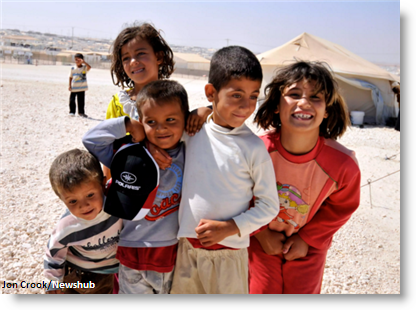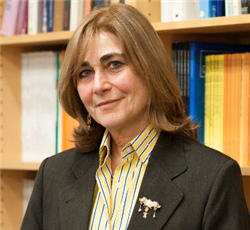 By Jacqueline Bhabha — The Mark News —
By Jacqueline Bhabha — The Mark News —
The current refugee crises around the world affect no more vulnerable population than child migrants, who face exploitation, confinement and even death as they seek safety from war, poverty and persecution. Even those children who make it through this gauntlet find they lack access to the education and training opportunities needed to tap into their potential.
In a recent paper, the UN Special Rapporteur on the Rights of Migrants noted: “Given the EU’s share of global resources and wealth of substantive normative standards, recent deaths at sea, the suffering seen at all stages of migration and other human rights issues have to be understood not as the result of some kind of powerlessness, but of political will and policy choices.” This observation applies with particular force to the predictable and severe rights violations suffered by hundreds of thousands of child refugees affected by the current Middle East upheavals. During 2015 alone, an estimated 26,000 unaccompanied children arrived in Europe, while a much larger number, well over 1 million, continue to languish in severely underfunded camps or settlements in or around Syria.
Unlike in previous decades, this child-specific fallout from conflict, violence and ensuing forced migration has been amply brought to recent public attention. It started in the spring and summer of 2014, with relentless images of Central American children crouched on the roofs of speeding trainsor huddled in freezing borderdetention centers as they sought refuge in the southern United States. President Obama described the 80,000 to 100,000-strong child migration (including over 65,000 unaccompanied child refugees) as a “humanitarian crisis,” but did nothing to increase access to safety. Instead, his administration increased the use of detention for children, including by funding substantial detention increases at Mexico’s southern border and supporting very high rates of deportation from Mexico back to the Northern Triangle, the most violent region in the world.
Evidence of the child-specific global fallout of migration continued, dramatically, with the unforgettable picture of 3-year-old Syrian Aylan Kurdi’s body washed up on the Turkish shoreline. This searing image almost overnight changed the attitude to reception of Syrian refugees in Canada, and drove distress child migration to the top of the European political agenda.The urgent imperative of taking particular measures to address the trauma and suffering of child refugees was further highlightedon May 5 by British Prime Minister David Cameron. His belated, but nonetheless welcome, announcement that Britain would accept a significant (though unspecified) number of unaccompanied child refugees from Syria was a response to insistent public reminders of contemporary parallels to the Jewish children rescued by Britain in World War II thanks to the “Kinder transport” scheme.
Making it to Europe is only the first step; it is not a guarantee of safety. On January 30, Europol announced that at least 10,000 unaccompanied child refugees had disappeared after arriving in Europe, many feared to have fallen into the hands of trafficking gangs. As recently as May 25, hundreds of child refugees awaiting access to Western Europe were forcibly separated from their parents and removed (including, according to eye witnesses, with the use of tear gas) from the site in Idomeni, in northern Greece adjacent to the Macedonian border.
The extreme situation of unaccompanied child refugees in and around the Mediterranean is not unique. Olivia Lopez, an ex-social worker engaged with migrant children in U.S. detention, reported to the U.S. House of Representatives that she had witnessed detained children refusedtreatment by medical staff until they needed emergency surgery, mothers moved into isolation for punishment and children left alone, unsure of their mothers’ whereabouts.
The circumstances of vulnerable child refugees from the Rohingya Muslim ethnic minority in Myanmar have also been documented. This religious and ethnic minority, long settled in the western Rakhine region of Myanmar, has faced severe persecution at the hands of the Buddhist majority, resulting both in extreme social and economic marginalization and in pervasive statelessness, a most fundamental denial of the community’s right to legal identity within the country. A pattern of large-scale distress migration has resulted, with Rohingya communities fleeing in search of security elsewhere. Among the 150,000 estimated refugees since 2012, the vast majority, including the unaccompanied children, are stateless and dependent on smugglers and traffickers for the travel documents necessary to secure entry into Thailand and Malaysia.During a2015 surge in Rohingya refugee flight across the perilous seasof the Bay of Bengal and the South Andaman,fatalities averaged 1.1 percent, three times the rate of refugees traveling in the Mediterranean. Royingya children as young as 10 have also been found in harsh transit camps, held by traffickers seeking to extort payment from family members or sell the children for labor or sexual exploitation.
The bleak situation of child refugees en route to a safe destination is one aspect of the unfolding tragedy. Anotheris the dearth of protective procedures on arrival at their destination. Despite 20 years of near-universal ratification of the 1989 UN Convention on the Rights of the Child, children are routinely placed in detention-like facilities while immigration inquiries are pursued, before they have the benefit of social welfare or medical support, and before they have the opportunity to seek legal or counseling advice. This is whyRohingya teenagers spend months in dangerous or exploitative circumstances trying to eke out a living under the control of smugglers in Malaysia, or in detention structures in Indonesia awaiting determination of their claim to asylum without the benefit of schooling or guardianship.
Unaccompanied child migrants may even be worse off, paradoxically, than similarly situated adults. Their claims to asylum are less likely to be recognized; their entitlements to other, nonfamily-based legal means of mobility(for training, apprenticeships, artistic pursuits) are more restricted;their abilities to navigate complex legal obstacles are less developed.
Child protection measures, such as prompt access to welfare authorities, to family tracing procedures, to guardianship, to free and quality legal representation and interpreting, to age-appropriate housing, health care and education, are essential. In the absence of strong political leadership and robust strategic planning to anticipate need and harm, the child-protection resource base is likely to become increasingly scarce, particularly if, as seems likely, numbers of child migrant arrivals continue to escalate.
In the face of this bleak scenario, what alternatives exist? One set of possibilities entails emulating the judicious and effective measures instituted already by some far-sighted strategic actors. Among them, one can point to the “one-stop shop” child-protection measures developed by the Swedish welfare authorities addressing the unusually large influx of unaccompanied Middle Eastern child migrants. These measures include integrated services for children, anchored in child protection needs but encompassing also legal immigration procedures, education and health provisions all offered in an integrated and supportive setting, geared towards protecting the child from further trauma or harm. Another good example is the U.S. special immigrant juvenile status visa, a unique immigration tool that grants permanent legal status to otherwise undocumented migrant children who have been abused, abandoned or neglected.
But these measures remain the exception. Instead we continue to witness millions of child migrants languishing without adequate access to sanitation, food, vaccination or education in refugee camps and other harsh settings around the world.
It is not only protective measures targeting unaccompanied migrant children that are largely absent. More radical, structural initiatives that address the migration flows in a broader context of global inequality and interdependency are even more dramatically lacking. Yet without them, no real solution to the child refugee crisis, or indeed the refugee and migration crisis more generally, is to be found.
We need to recognize the imperative of democratizing and globalizing access to quality education; not merely to locally based primary education and the literacy and numeracy it is supposed to deliver, but to the quality secondary and tertiary education in increasing supply in a graying North, essential in a post-industrial era. Mechanization and computerization are reducing the need for non service-based or location-specific unskilled labor, but are conversely increasing the demand for technical, technological, scientific and cognitively sophisticated skill sets.
This employment and demographic shift entails a refiguring of migration management away from a linear model and towards a circular model; away from the notion of a one-way flow of human or technical resources across south-north borders, and towards a multi-stage process. In this model, educational opportunity as a global public good is supported by legal migration options. These initiatives are closely tied to the enhancement of well structured, and rigorously monitored, skill training and apprenticeship options to follow the educationoptions which can be developed in a range of settings.
Schemes to make quality higher education available to refugees, to displaced, stigmatized or marginalized populations are already being explored in a range of contexts. They are fledgling initiatives, poorly funded but visionary in their grasp of the potential for technology-mediated exponential growth of educational opportunity. An approach that incorporates elements of this integrated vision of child protection and youth mobility, and that promotes access to quality education and skill training for all young people, has a better chance of reducing current distress child migration than the border-control fixes currently being attempted. Most important, an approach such as this one has the potential to treat all children as children first and foremost; to recognize their potential for growth, exploration and ambition, and to reward and support it.
 Jacqueline Bhabha, JD, MsC is Professor of the Practice of Health and Human Rights at the Harvard T.H. Chan School of Public Health. She is director of research at the Harvard FXB Center for Health and Human Rights, the Jeremiah Smith Jr. Lecturer in Law at Harvard Law School, and an adjunct lecturer in public policy at the Harvard Kennedy School. From 1997 to 2001 Bhabha directed the Human Rights Program at the University of Chicago. Prior to 1997 she was a practicing human rights lawyer in London and at the European Court of Human Rights in Strasbourg. She has published extensively on issues of transnational child migration, refugee protection, children’s rights and citizenship. She serves on the board of the Scholars at Risk Network, the World Peace Foundation, and the Journal of Refugee Studies.
Jacqueline Bhabha, JD, MsC is Professor of the Practice of Health and Human Rights at the Harvard T.H. Chan School of Public Health. She is director of research at the Harvard FXB Center for Health and Human Rights, the Jeremiah Smith Jr. Lecturer in Law at Harvard Law School, and an adjunct lecturer in public policy at the Harvard Kennedy School. From 1997 to 2001 Bhabha directed the Human Rights Program at the University of Chicago. Prior to 1997 she was a practicing human rights lawyer in London and at the European Court of Human Rights in Strasbourg. She has published extensively on issues of transnational child migration, refugee protection, children’s rights and citizenship. She serves on the board of the Scholars at Risk Network, the World Peace Foundation, and the Journal of Refugee Studies.





